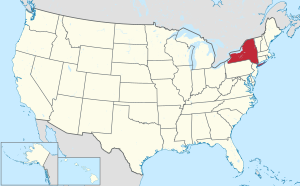
Back مقاطعة ألباني (نيويورك) Arabic آلبانی بؤلگهسی، نیویورک AZB Albany County, New York BAR Олбани (окръг, Ню Йорк) Bulgarian আলবেনী কাউন্টি, নিউ ইয়র্ক BPY Comtat d'Albany (Nova York) Catalan Albany Gông (New York) CDO Олбани (гуо, Нью-Йорк) CE Albany County (kondado sa Tinipong Bansa, New York) CEB Albany County (New York) Czech
Albany County | |
|---|---|
 | |
 Location within the U.S. state of New York | |
 New York's location within the U.S. | |
| Coordinates: 42°39′44″N 73°50′57″W / 42.662094°N 73.849075°W | |
| Country | |
| State | |
| Founded | November 1, 1683[a] |
| Named for | Prince James, Duke of York and of Albany |
| Seat | Albany |
| Largest city | Albany |
| Area | |
• Total | 533 sq mi (1,380 km2) |
| • Land | 523 sq mi (1,350 km2) |
| • Water | 10 sq mi (30 km2) 2.0% |
| Population | |
• Estimate (2020) | 314,848[1] |
| • Density | 602.13/sq mi (232.48/km2) |
| Time zone | UTC−5 (Eastern) |
| • Summer (DST) | UTC−4 (EDT) |
| Congressional district | 20th |
| Website | albanycountyny.gov |
Albany County (/ˈɔːlbəni/ ⓘ AWL-bə-nee) is a county in the state of New York, United States. Its northern border is formed by the Mohawk River, at its confluence with the Hudson River, which is to the east. As of the 2020 United States Census, the population was 314,848.[2] The county seat and largest city is Albany,[3] which is also the state capital of New York. As originally established by the English government in the colonial era, Albany County had an indefinite amount of land, but has had an area of 530 square miles (1,400 km2) since March 3, 1888. The county is named for the Duke of York and of Albany, who became James II of England (James VII of Scotland). The county is part of the Capital District region of the state.
Cite error: There are <ref group=lower-alpha> tags or {{efn}} templates on this page, but the references will not show without a {{reflist|group=lower-alpha}} template or {{notelist}} template (see the help page).
- ^ "US Census 2020 Population Dataset Tables for New York". United States Census Bureau. Retrieved January 2, 2022.
- ^ "U.S. Census Bureau QuickFacts: Albany County, New York; United States". Census.gov. Retrieved July 20, 2022.
- ^ "Find a County". National Association of Counties. Archived from the original on May 31, 2011. Retrieved June 7, 2011.

